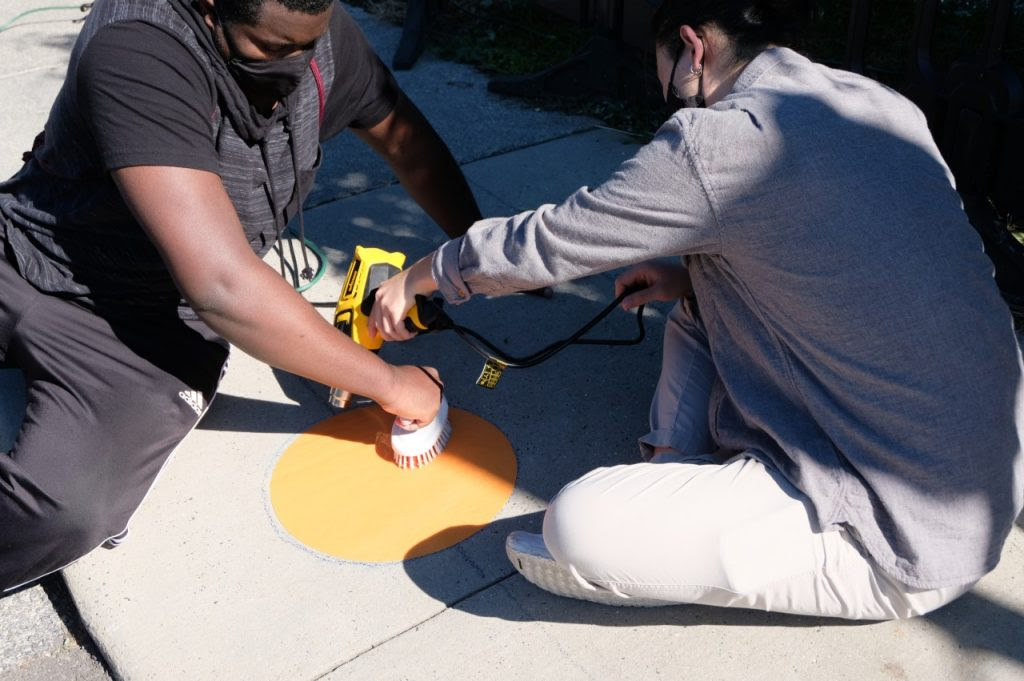
Thanks to Virginia Tech students Kirat Pandher and Joonyoung Kang, Blacksburg residents and visitors have visual cues to help them remember to maintain safe distances in some of the community’s most heavily frequented areas: Hokie Circles.
The students’ project uses boundary circles and printed decals to show Blacksburg residents and Virginia Tech students where they can safely gather and stand.
“Our simple and clean graphics act as a low-tech way to nudge people to socially distance themselves,” said Pandher. “As architecture students, we decided that we would be best suited to give a spatial response to the problem.”
In the summer of 2020, Pandher and Kang introduced two ideas they believed would help solve some of the challenges connected to the pandemic guidelines for physical distancing: decals for sidewalks and spray-painted boundary circles for grassy areas. Once their idea was adopted, the strategies were installed in two heavily trafficked areas: the Blacksburg Farmers Market and Virginia Tech’s drill field.
Small groups of people, such as family groups or pods, can gather within the circles knowing that as long as they remain inside the painted boundaries, there is no fear of intruding on another group’s safety.
The decals, which appear along the sidewalks where Farmers Market guests queue, help ensure proper distance as customers wait their turn to make purchases.
“Starting with the Blacksburg Farmers Market, we have already seen our invention impact the way residents distance themselves,” said Kang. “It can be difficult to visualize what six feet actually is. Hokie Circles solves that problem. We are implementing Hokie Circles where people like to gather, such as public lawn spaces, hopefully creating a sense of responsibility to social distance.”
The idea for Hokie Circles was born as part of the TECH Together Campaign, a joint initiative with the Fralin Life Sciences Institute; the Institute for Society, Culture, and Environment; the Institute for Critical Technology and Applied Science; and the Institute for Creativity, Arts, and Technology. The initiative supports projects and innovation by offering $5,250 grants to students who develop ideas to improve student life in Blacksburg during the pandemic.
“The students wanted a voice in the message that community members should social distance,” said Aki Ishida, associate professor in the School of Architecture + Design and Kang and Pandher’s advisor and faculty member on the team. “Through the initiative, the student’s voice is introduced into the conversation about safety in Blacksburg. Guidance for students and community members is not just coming from above in the university administration, but also from the bottom up.”
Out of 79 entrants, Hokie Circles was one of only five projects and the sole architecture-focused group to receive full funding from the university. The project earned immediate praise from community members and has proven to be an efficient and effective way to promote safety in public areas.
“Hokie Circles is the perfect example of a student’s simple solution to a complex problem,” said Kiyah Duffey, director of strategic innovations in the Fralin Life Sciences Institute and one of the campaign judges. “It truly was a revolutionary idea. The circles change the way folks comprehend social distancing. The visual on the project is really beautiful and has had exactly the impact we had hoped.”
With an idea and a budget in place, the student duo turned their focus to the materials required to deliver their idea to the Blacksburg community. They looked within their own network for someone who could help them out. Ishida, who was their faculty team member and the daughter of a chemist from 3M, a major American materials conglomerate, was the right person for the job.
“When I told 3M what this new application was for, they were very excited and wanted to be part of the effort,” said Ishida. “[VT alumnus and 3M division scientist] Matt Johnson liked that it was student initiated, served the community, and would be implemented on or near his old campus. 3M supplied all of the graphic signage materials.”
Kang and Pandher used the funding from Virginia Tech to produce the graphic elements. The orange dots were pressed onto the sidewalk that wraps around the farmers market lawn. The dots, in tandem with the spray-painted rings on the market lawn and on the drill field, have effectively created a safer environment for Blacksburg residents and Virginia Tech students.
“The tone of the message is different when it is not only the town or the government putting out signage but also students carrying out their own fun and creative solution,” said Ishida. “The dots are more playful than signs you might see elsewhere. We have seen people hopping on them. I have seen a roller blader slalom skating through the dots. These social distancing tools foster a good town-university relationship.”


